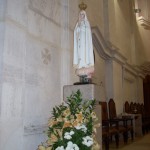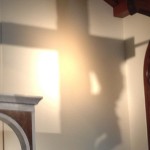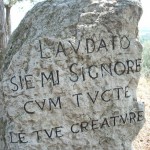Jesus said,
“Let him who seeks continue seeking until he finds.
When he finds, he will become troubled.
When he becomes troubled, he will be astonished . . .”
~ The Gospel of Thomas (Coptic), Logion 2
On the Sunday after Easter, we meet Thomas–one of the most intriguing of the Apostles. Oh sure, the familiar Gospel reading from John makes him a kind of dolt, a believer-come-lately who somehow manages to miss the first appearance of the Risen Christ to the Apostles and responds to accounts of that appearance with frank skepticism. “Yeah, right, Rocky,” we can imagine him saying to Peter. “Tell me another one.”
It’s this refusal to settle for second-hand Resurrection, and a thickheaded insistence on sensory verification (“unless I put my finger into the nail marks”), that has saddled Thomas with his best known sobriquet, Doubting. In the paintings that depict the moment when Thomas finally does encounter Jesus, the Doubter is Stooge-like, poking around in the wound in Jesus’ side as though he were about to say Nyuk nyuk instead of My Lord and my God!
But he does say My Lord and my God!–confessing what none of the others, the non-doubters, had yet recognized. When I was a child, I was taught to pray that same confession silently at the Elevation of the Host and the Chalice at Mass, thus firmly reinforcing my identification with Thomas as both doubter (“Can this really be Jesus?”) and believer (“Yes!”). The habit stuck.
The account of Thomas’s post-Resurrection doubt is not the only occasion in John’s Gospel when Thomas is made to play the fool. In John 14, at the Last Supper, Thomas interrupts Jesus’ farewell with what has to be the stupidest question any Apostle ever asked (and considering how often Jesus rolled his eyes at this gang, that’s going some). “Where I am going, you know the way,” Jesus says. And Thomas–you can just see him raising his hand frantically like Arnold Horshack–says, “Master, we do not know where you are going; how can we know the way?” Duh! Here, too, though, Thomas’s incredulity draws back the curtain on an answer larger than his question could contain: “I am the way and the truth and the life. No one comes to the Father except through me.”
Thomas’s reputation for doubt followed him outside the pages of Scripture. In the apocryphal accounts of the end of Mary’s life, she is given enough advance warning to send word to the Apostles to assemble at her deathbed. No matter how far their witnessing has taken them, all return in time for a last goodbye, and are present when Mary is assumed into heaven. All, of course, except Thomas, who rushes in just minutes late, sees the empty bed, and runs outside, refusing to believe that angels have borne Mary away. As he kneels, inconsolable, by her unused tomb, down from the clouds drifts a parting Nyuk nyuk from Mary herself–her girdle (not the whaleboned Maidenform undergarment I imagined when I first heard this tale, but the sash that tied her robe) tossed gently into Thomas’s outstretched hands. The purported girdle itself is enshrined in a Syrian Orthodox church in–see if this doesn’t give you chills to learn this week; it did me–the horrifically beleaguered city of Homs.
But Thomas has other names and other roles than doubter. In Southern India, where legend says he evangelized and met a martyr’s death, he is Mar Thoma (Holy Thomas), with fingers and toes in reliquaries scattered among the “seven and a half churches” that make up one of Christianity’s oldest and oddest outposts. The Thomas Christians of Kerala became today’s Mar Thoma Church, independent yet allied with Syrian Orthodoxy (which is how the girdle made its way to Homs, along with other relics of Thomas re-imported to the Middle East from India).
A tradition that may predate John’s Gospel gives Thomas the name Judas Thomas, and honors him as the collector of the sayings of Jesus known as The Gospel of Thomas. Though not specifically Gnostic itself, The Gospel of Thomas does contain elements of Greek and Egyptian Gnosticism. It includes much that is strikingly similar to the sayings of Jesus contained in the Synoptic Gospels (Matthew, Mark, and Luke), and much that is just as strikingly different. There are echoes of sayings that will occur in later Islamic tradition. The Gospel of Thomas gives us a very different portrait of Thomas than that found in John. Here, Thomas is the wise one, the Apostle to whom Jesus reveals his most intimate thoughts and most powerful teachings. For centuries, the world only knew this text through its condemnation as heresy by early Church Fathers. Fragments in Greek were available, but a fuller text, in Coptic, did not appear until the discovery of the Nag Hammadi library in the 1940s. Since then, The Gospel of Thomas has been widely studied. There are those, like scholar of Gnosticism Elaine Pagels, who believe that the portrait of Doubting Thomas in John was actually developed to counter the popularity of Wise Thomas among competing early churches more influenced by Gnosticism. John’s Gospel dumbs Thomas down for the sake of orthodoxy. It would have been a particularly pointed jab at Gnostics, who scorned the fleshly senses, to make Thomas’s faith so reliant on them.
Heterodox or not, The Gospel of Thomas contains a powerfully stirring portrait of the true disciple as one who never stops doubting, never stops seeking, never stops asking–because the product of such seeking is astonishment. My Lord and my God!
Finally, there is Thomas’s real name. In Aramaic, Thomas means “twin”; he is also sometimes known by the Greek for twin, Didymus. The canonical Gospels do not provide any information on who Thomas’s twin might be; unlike Simon and Andrew or James and John, he is not one of a pair of apostolic brothers. The Gospel of Thomas has Jesus call Thomas his own twin–not in blood, but in shared wisdom. It’s possible, some scholars think, that Thomas looked enough like Jesus to be called his twin or his double. If that were true, imagine the jolt of that moment when Thomas does get to see and touch the Risen Lord–like looking in a mirror, no longer through a glass darkly but utterly transformed.
I like to think that in the end, Thomas is the twin of each and every one of us, made in the image and likeness of our Lord and our God and called to doubt, to seek, to be troubled, to believe, to be astonished, and to carry that good news to the ends of the earth. Because Thomas dared to ask, we know the Way.
UPDATE: My pastor, Fr Gerald Haemmerle, was thinking about Thomas in a positive way yesterday, too. Here’s his homily.











